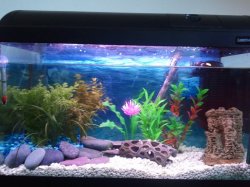andyboot
New Member
- Joined
- Mar 28, 2012
- Messages
- 28
- Reaction score
- 0
Hello all,
I'm new to here and the fish scene, so please excuse my lack of knowledge on the subject (still learning!).
I have a 52 litre tank, set at 26 degrees Celsius. Contains a Fluval U2 underwater filter, a few plants (real and fake), gravel, pebbles and a few decorations.
Added 6 Harlequin rasbora to the tank after 5 days after adding the water and switching on the heater & filter. I was advised and read somewhere that it was okay to do so, though after doing more research on the net after the dilemma I since discovered that I perhaps should have waited?
Anyways what's done is done. When the first died I was asked by the pet shop to bring a sample of water, they did a test for Ph, Ammonia and Nitrite. The girl advised that the Ph was perhaps a little too high (I don't think she was too sure to be honest). Unfortunately by the time I managed to get to the pet shop four had already died. Three of the fish are accounted for however one is nowhere to be found. I walked away with four more fish (they replaced them for free) and some solution called Ph Down (contains sulfuric acid). Got home to find another dead
Gradually added the Ph Down which did eventually bring it right down to 6.0. After 24 hours all seemed well and all the fish appeared to be happy enough. Last night the last remaining fish (of the original six) started doing the same as the other previous fish by acting really unsocialable by hiding between the filter and the suction cups. Went to bed for the night and woke up to find that this one had also vanished. I'm starting to think these fish eat each other when dead?
Anyways, I've just done a test just now and here are the results:
Nitrite - 0
Ph - 6.4 - 6.6
Ammonia - 0
Photo of the test
Somebody has suggested it may be due to there not being enough "good bacteria" and advised adding a dead prawn or shrimp to boost the bacteria build up, but I'm not really convinced.
Any help would be gratefully appreciated!
Thanks in advance,
Andy.
I'm new to here and the fish scene, so please excuse my lack of knowledge on the subject (still learning!).
I have a 52 litre tank, set at 26 degrees Celsius. Contains a Fluval U2 underwater filter, a few plants (real and fake), gravel, pebbles and a few decorations.
Added 6 Harlequin rasbora to the tank after 5 days after adding the water and switching on the heater & filter. I was advised and read somewhere that it was okay to do so, though after doing more research on the net after the dilemma I since discovered that I perhaps should have waited?
Anyways what's done is done. When the first died I was asked by the pet shop to bring a sample of water, they did a test for Ph, Ammonia and Nitrite. The girl advised that the Ph was perhaps a little too high (I don't think she was too sure to be honest). Unfortunately by the time I managed to get to the pet shop four had already died. Three of the fish are accounted for however one is nowhere to be found. I walked away with four more fish (they replaced them for free) and some solution called Ph Down (contains sulfuric acid). Got home to find another dead
Gradually added the Ph Down which did eventually bring it right down to 6.0. After 24 hours all seemed well and all the fish appeared to be happy enough. Last night the last remaining fish (of the original six) started doing the same as the other previous fish by acting really unsocialable by hiding between the filter and the suction cups. Went to bed for the night and woke up to find that this one had also vanished. I'm starting to think these fish eat each other when dead?
Anyways, I've just done a test just now and here are the results:
Nitrite - 0
Ph - 6.4 - 6.6
Ammonia - 0
Photo of the test
Somebody has suggested it may be due to there not being enough "good bacteria" and advised adding a dead prawn or shrimp to boost the bacteria build up, but I'm not really convinced.
Any help would be gratefully appreciated!
Thanks in advance,
Andy.



 to the forum, andy, and I'm sorry for your losses.
to the forum, andy, and I'm sorry for your losses.